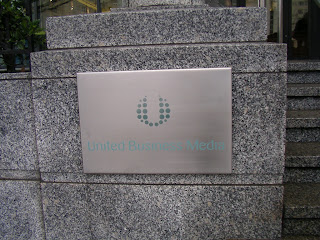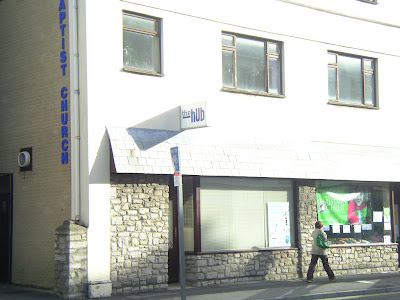Tony Jian, 11 Dec 2007
Warning: The names and some places in the profile have been changed to garantee anonymity and to protect "Ken's" working rights.
Seeing in the Dark
He is definitely a man with perseverance. In the eyes of his friend, Christina Yamamoto, "He is very confident. He is a sort of a motivator. Not arrogant but very confident. Now I still see a very confident man despite everything."
"Me llamo Ken y soy el intérprete de español. ¿Cómo puedo ayudarle? Hello, my name is Ken. I am the Spanish (or French) interpreter. How can I help you?…"
A cheerful ring from another client breaks in on his landline. Too bad he can't perform an interpreting duo. In the end, the preluding ring diminishes into an ornament that embellishes the melody of the Spanish and English solo by Ken López Hodder.
"Sometimes you get a lot. Sometimes you don't get anything for ages." He gives a jocular yet truthful comment on the frequency of interpreting job assignments after finishing the conference call. He reaches out his hands to the keyboard as if ready to play a sonata and out comes a collage of sounds from a screen reader on his computer. A black Labrador at Ken's feet pricks up its ears, stretches and nuzzles with its head between his legs.
"His name is Paka. It means 'goodbye' in Russian," Ken explains while stroking its sleek fur. This smart companion has been a life support for Ken for more than a year and has always brought great attention to him wherever they go.
Ken was born prematurely in Spain in 1981 and has undergone 14 operations since he came to this world. His twin died shortly afterwards. He lived on but was left with hydrocephalus. As a result, his doctor put a shunt in his head and a catheter that went all the way down to evacuate the fluids in his meninges. During the last operation in 2001, the doctor saw the catheter was not working. They didn't know how he was still alive. They took the catheter out but left the shunt in, which got infected in the theatre. The infection caused abscess in his brain and filled his head with pus. Consequently, the increased intracranial pressure squashed his optic nerve.
This tragedy hit hard on his family and forced Ken to stop his study of translation and interpreting in French and Spanish in YYY University, Spain.
"Ken cried with my wife, Rachel, and thought everything had finished and he couldn't get married. He asked many distressing questions," Juan López Marcos, Ken's father recalls.
"Before (blindness) I used to be very secure. And all of a sudden, every step forward was a potential collision. So the sense of security went totally," Ken confesses but says he has regained confidence because of the love of his parents and God.
Juan remembers one day he thought of St. Paul asking for help three times from the Lord. In the end, the Lord said to him, "My grace is sufficient for you for my power is made perfect in weakness" (2 Corinthians 12:9) Paul understood this and relied on the Lord.
"The next day when I went to see Ken in the hospital, before saying anything to him, I saw a get well card from a friend quoting the same verse. So I thought, 'Thank you, Lord. This is what you want me to tell Ken to encourage him,'" Juan says.
Before Ken was discharged from the hospital after he'd recovered from a coma, his parents contacted the RNIB (Royal National Institute of the Blind), which sent Malvin Kitzerson, a social worker who is also blind, to teach him the basics.
"It was a hard process but as well a funny one," Ken comments.
"The first time when I was doing my mobility with my cane outdoors, a pedestrian saw me and we started talking. In the end, she told me she had a dog. I had only been blind for a couple of weeks. I thought I would be able to feel more now that I was blind. So I asked the pedestrian if I could stroke the dog. I wanted to see if it felt different. She said by all means. So I knelt down and stroked the dog. And I asked her, "What is it?" thinking she would say a Labrador, an Alsatian, etc. All of a sudden, my mobility instructor, from 20 metres behind me, shouted, "Ken! That's the lady's leg." I blushed. I must say in my defence I had gloves and it was winter. I couldn't tell the difference."
He practiced Braille four hours everyday and was able to "read" again in six and half months.
"Call a spade a spade! Political correctness is silly. There's no way you can change it. To avoid using the word 'see' is just highlighting the fact I can't see. I'm not worried about it why should you?"
His friend and neighbour Christina Yamamoto admits she also struggled a bit over the "right verb" in the beginning. "He often invites friends over. He might say, 'Come around and watch a DVD.' I thought that's no fun for you. Why would you want them to watch a DVD when you can't profit from watching it properly. I suppose he wants to, despite his blindness, lead as normal life as possible. He doesn't want his blindness to be a stumbling block for other people. Not to make an inhibition for him to have friends."
In fact, Ken has many of them from around the world. On the way up stairs to his room, there is a piece of paper on the wall with the sentence "Jesus loves you" in many different languages written by his international friends.
He likes to collect multilingual phrases such as "Happy Birthday", "Jesus Loves You" and the most recent one---"Merry Christmas".
His linguistic talent and amiable smile have made it easy for him to make friends. He can say "Hello" in 31 languages including Mandarin Chinese, German, Dutch, Greek, Turkish, Russian, Farsi, Yiddish, Swahili, Hindi, etc. Whenever he meets friends from a certain country, he can always greet them in their own language.
Thanks to blindness, "I no longer see the differences in people. I like not being able to judge a book by its cover. Now for me everybody looks exactly the same. I love that. I feel free," Ken reveals.
Having learned basic survival skills one year after the tragedy, Ken decided to go back to university. "But in Spain they didn't have the means for me to continue. So we decided to move to England."
He was accepted by the University of XXX and was the first blind student the school had ever had. Because the school was quite accommodating and Ken liked interpreting so much that he did an MA in Translation and Interpreting at the same university for two more years while studying the Diploma in Public Service Interpreting (DPSI) in the legal and medical options simultaneously.
The MA programme focused a lot more on conference interpreting, which also led to an intern opportunity at the UN in Vienna.
"I've always wanted to be an interpreter since I was a kid. The difficulty of my Spanish family not being able to communicate with my English family has prompted me to choose this career."
You would probably think with his linguistic talent and strong motivation he must have gotten his first job fairly easily. Not if the client has prejudice against blind people. Ken had been jobless for six months after graduation until he decided not to disclose sightlessness in his CV.
"Everything is ready but as soon as they learn I am blind, they go, 'Oh! That's fine. We'll call you later.'"
"Of course, they never do."
"I have lost my sight but not my brains."
Despite all the hardship, Ken didn't give up. He started out by offering telephone interpreting services and worked as a translator on the side. Now he has clients from the UK, the US, Spain, and countries in Latin America. He has done several conference interpreting sessions in south England and will be making his interpreting debut in a west African country in February next year.
"I'm looking forward to it," Ken gives a chuckle. The client in queue rings again. He turns his back, picks up the phone and interprets his Spanish and English solo with a sanguine tone: "Me llamo Ken y soy el intérprete de español. ¿Cómo puedo ayudarle? Hello, my name is Ken. I am the Spanish (or French) interpreter. How can I help you?…"
 面對鏡頭的那位女士是世界自然基金會印度分會 (WWF India) 的能源氣候政策協調人 Ms Shruti Shukla, 右方訪問她的那位男士是 OneWorld 的線上編輯 Daniel Nelson. 鏡頭外還有兩個工作人員: 一個在攝影的同時, 另一個在 Second Life 裡面負責蒐集整理來自世界各地與會者的問題, 再交由 Mr Nelson 提問.
面對鏡頭的那位女士是世界自然基金會印度分會 (WWF India) 的能源氣候政策協調人 Ms Shruti Shukla, 右方訪問她的那位男士是 OneWorld 的線上編輯 Daniel Nelson. 鏡頭外還有兩個工作人員: 一個在攝影的同時, 另一個在 Second Life 裡面負責蒐集整理來自世界各地與會者的問題, 再交由 Mr Nelson 提問. 介紹的人員說現在的總部以前是個倉庫, 規模之大可想而知. 我們先從二樓往下俯瞰新聞室, 每個人都像八爪章魚一樣忙個不停, 分工也很細. 基本的採訪, 編輯團隊少不了, 另外還有國際新聞組, 網路新聞組, 研究企劃組, 運動新聞組 (這是 Sky 的強項), 還有新成立的廣播新聞組, 預計作為提供其他媒體 24 小時廣播新聞的單位.
介紹的人員說現在的總部以前是個倉庫, 規模之大可想而知. 我們先從二樓往下俯瞰新聞室, 每個人都像八爪章魚一樣忙個不停, 分工也很細. 基本的採訪, 編輯團隊少不了, 另外還有國際新聞組, 網路新聞組, 研究企劃組, 運動新聞組 (這是 Sky 的強項), 還有新成立的廣播新聞組, 預計作為提供其他媒體 24 小時廣播新聞的單位.







 The weather turned cloudy at noon.
The weather turned cloudy at noon.







































